Abstract
Various naturally occurring carbohydrates, applied at a concentration range of 1 to 100 mm, stimulated ethylene production for several days in indoleacetic acid (IAA)-treated or untreated tobacco (Nicotiana tabacum L. cv `Xanthi') leaf discs. The lag period for this sugar-stimulated ethylene production was 8 to 12 hours after excision in the untreated leaf discs, but less than 2 hours in the IAA-treated ones. Among the tested carbohydrates, 12 were found to increase synergistically ethylene production, with d-galactose, sucrose, and lactose being the most active; mannitol and l-glucose had no effect. The extent and duration of the increased ethylene production was dependent upon the type of sugar applied, the tissue's age, and the existence of both exogenous IAA and sugar in the medium. Sucrose appeared to elicit a continuous IAA effect for 48 hours, as expressed by increased ethylene production, even when IAA was removed from the medium after a 4-hour pulse. Sucrose stimulated both the uptake and decarboxylation of [1-14C]IAA, as well as the hydrolysis of the esteric and amide IAA conjugates formed in the tissue after application of free IAA. This gradual hydrolysis was accompanied by a further accumulation of a third IAA metabolite. Moreover, synthetic indole-3-acetyl-l-alanine increased ethylene production mainly with sucrose, and this effect was accompanied by its increased decarboxylation and turnover pattern suggesting that release of free IAA was involved. An esteric IAA conjugate, tentatively identified by GC retention time was found to be the major component (84%) of the naturally occurring IAA conjugates in tobacco leaves. Accordingly the sucrose-stimulated ethylene production in tobacco leaves can be ascribed mainly to the sucrose-stimulated hydrolysis of the esteric IAA conjugate.
Full text
PDF
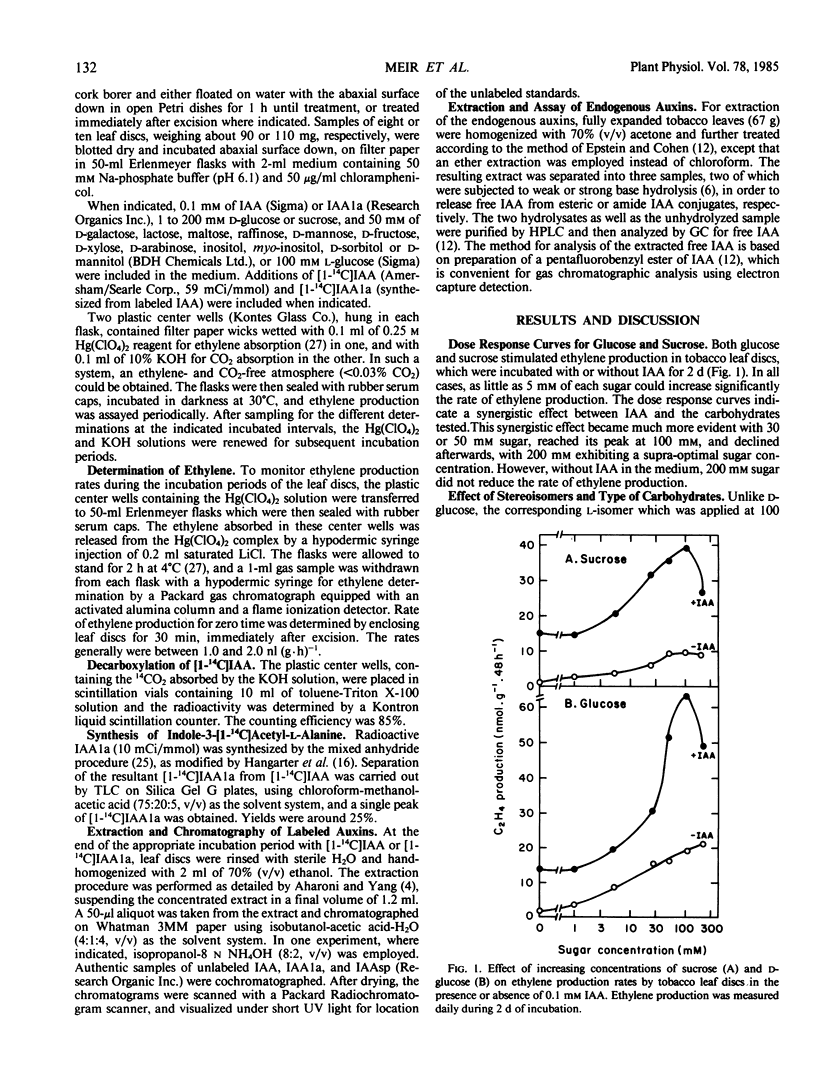
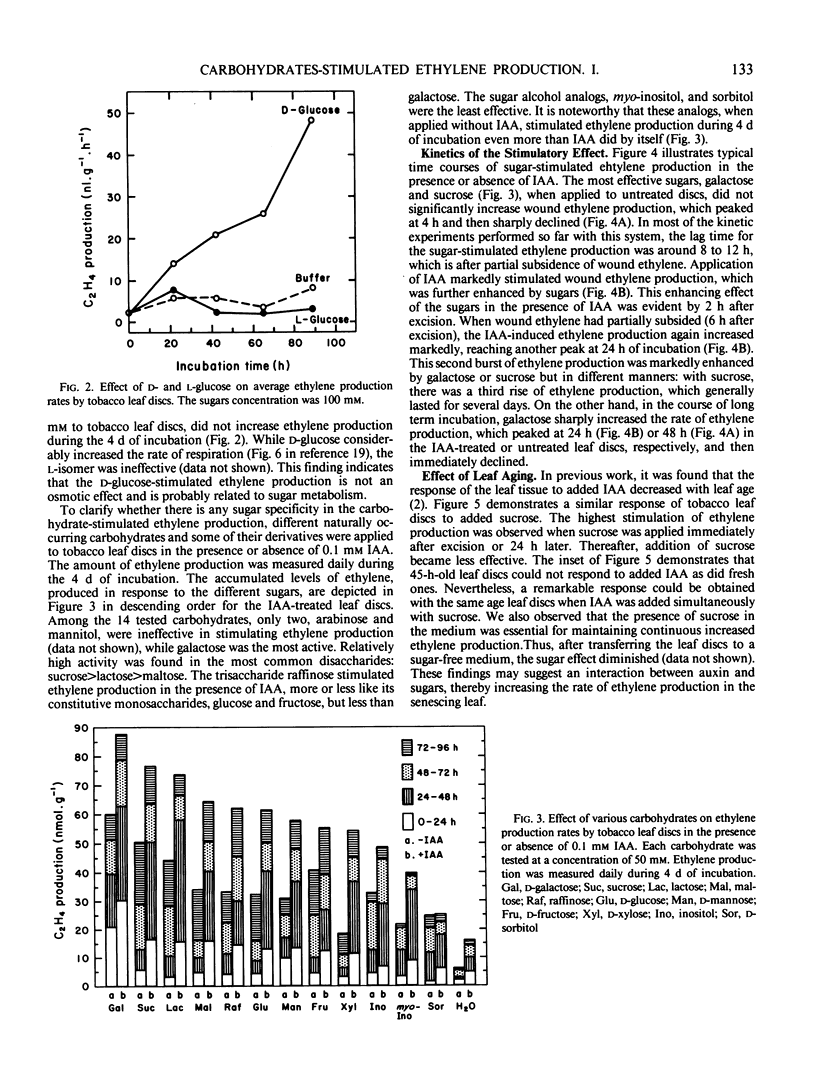
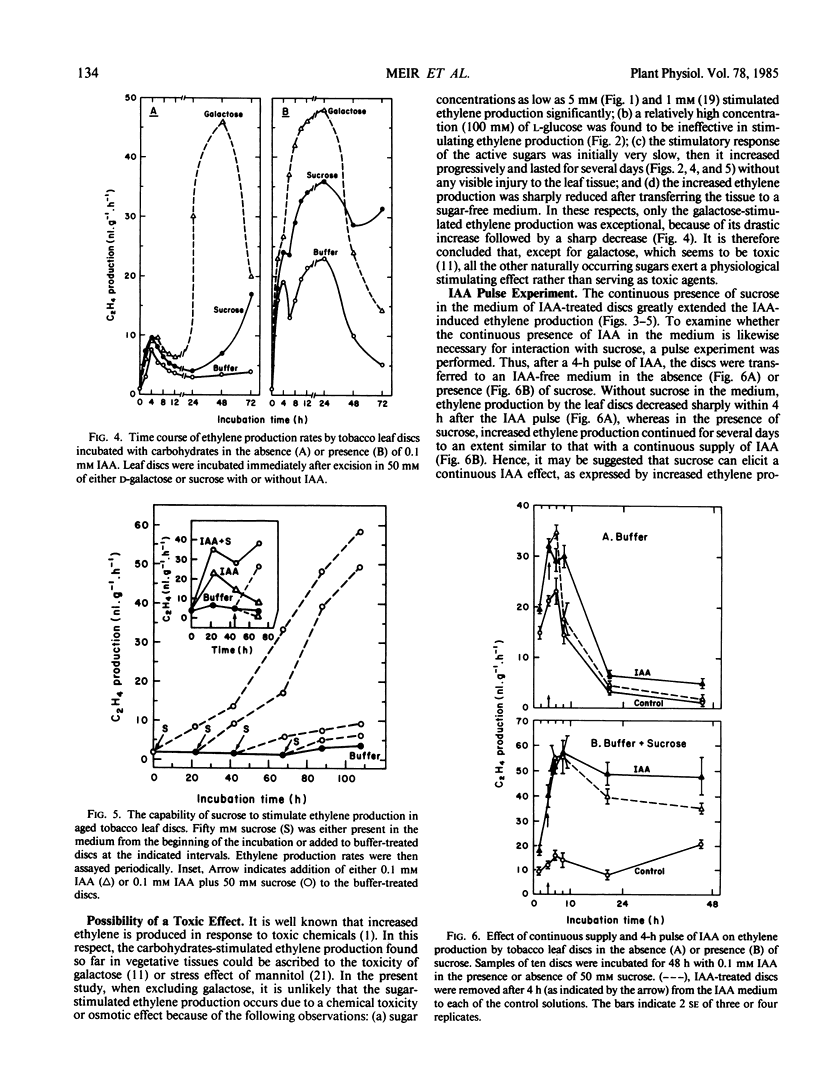

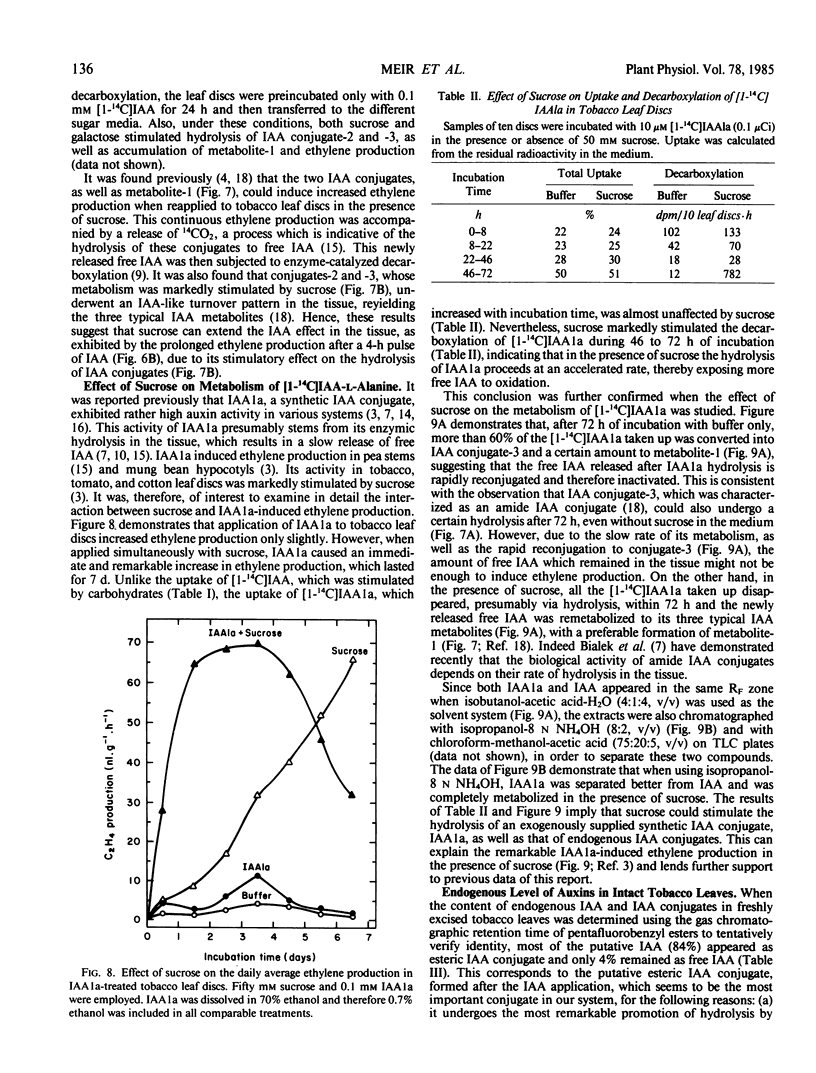
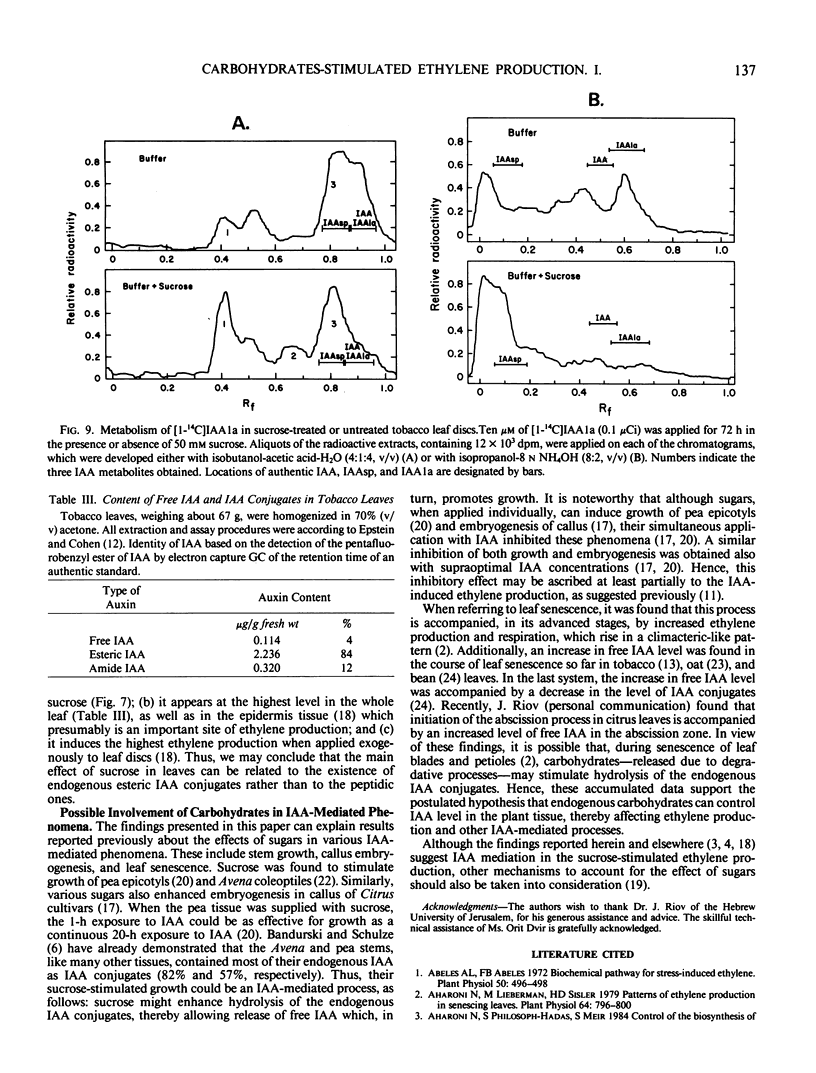
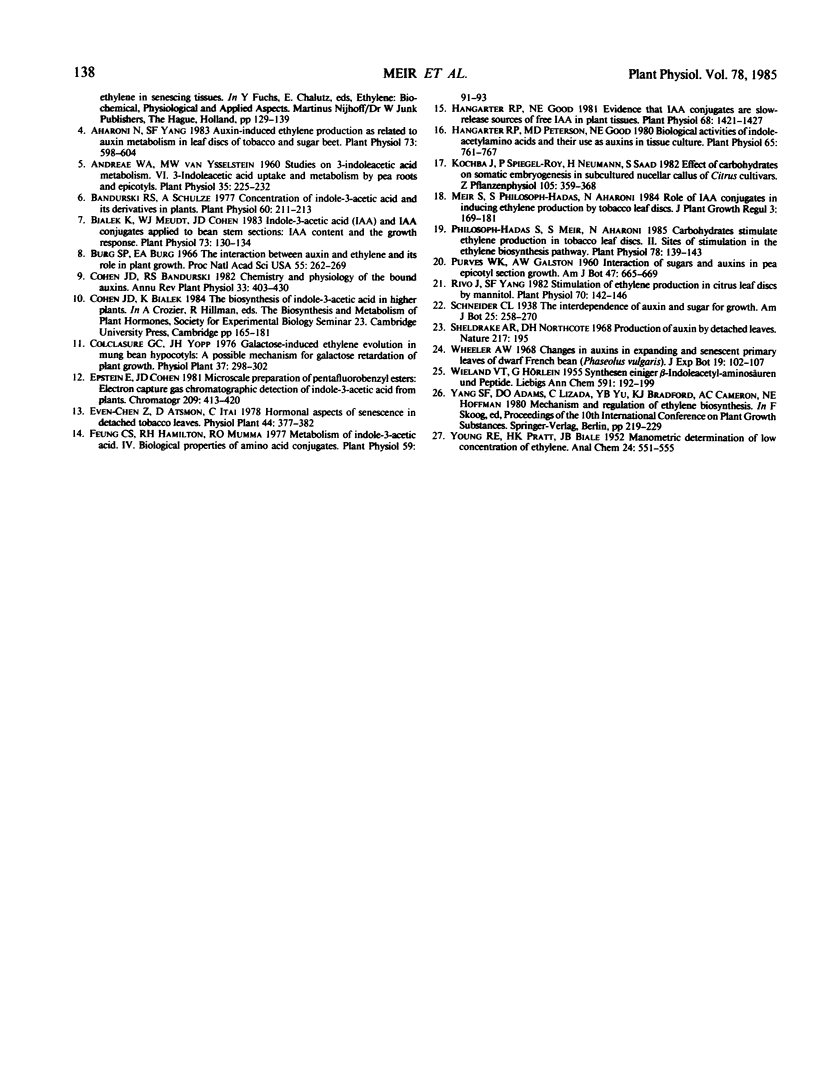
Selected References
These references are in PubMed. This may not be the complete list of references from this article.
- Abeles A. L. Biochemical Pathway of Stress-induced Ethylene. Plant Physiol. 1972 Oct;50(4):496–498. doi: 10.1104/pp.50.4.496. [DOI] [PMC free article] [PubMed] [Google Scholar]
- Aharoni N., Lieberman M. Patterns of ehtylene production in senescing leaves. Plant Physiol. 1979 Nov;64(5):796–800. doi: 10.1104/pp.64.5.796. [DOI] [PMC free article] [PubMed] [Google Scholar]
- Aharoni N., Yang S. F. Auxin-induced ethylene production as related to auxin metabolism in leaf discs of tobacco and sugar beet. Plant Physiol. 1983 Nov;73(3):598–604. doi: 10.1104/pp.73.3.598. [DOI] [PMC free article] [PubMed] [Google Scholar]
- Andreae W. A., Van Ysselstein M. W. Studies on 3-Indoleacetic Acid Metabolism. VI. 3-Indoleacetic Acid Uptake and Metabolism by Pea Roots and Epicotyls. Plant Physiol. 1960 Mar;35(2):225–232. doi: 10.1104/pp.35.2.225. [DOI] [PMC free article] [PubMed] [Google Scholar]
- Bandurski R. S., Schulze A. Concentration of Indole-3-acetic Acid and Its Derivatives in Plants. Plant Physiol. 1977 Aug;60(2):211–213. doi: 10.1104/pp.60.2.211. [DOI] [PMC free article] [PubMed] [Google Scholar]
- Bialek K., Meudt W. J., Cohen J. D. Indole-3-acetic Acid (IAA) and IAA Conjugates Applied to Bean Stem Sections: IAA Content and the Growth Response. Plant Physiol. 1983 Sep;73(1):130–134. doi: 10.1104/pp.73.1.130. [DOI] [PMC free article] [PubMed] [Google Scholar]
- Burg S. P., Burg E. A. The interaction between auxin and ethylene and its role in plant growth. Proc Natl Acad Sci U S A. 1966 Feb;55(2):262–269. doi: 10.1073/pnas.55.2.262. [DOI] [PMC free article] [PubMed] [Google Scholar]
- Hangarter R. P., Good N. E. Evidence That IAA Conjugates Are Slow-Release Sources of Free IAA in Plant Tissues. Plant Physiol. 1981 Dec;68(6):1424–1427. doi: 10.1104/pp.68.6.1424. [DOI] [PMC free article] [PubMed] [Google Scholar]
- Hangarter R. P., Peterson M. D., Good N. E. Biological activities of indoleacetylamino acids and their use as auxins in tissue culture. Plant Physiol. 1980 May;65(5):761–767. doi: 10.1104/pp.65.5.761. [DOI] [PMC free article] [PubMed] [Google Scholar]
- Philosoph-Hadas S., Meir S., Aharoni N. Carbohydrates Stimulate Ethylene Production in Tobacco Leaf Discs : II. Sites of Stimulation in the Ethylene Biosynthesis Pathway. Plant Physiol. 1985 May;78(1):139–143. doi: 10.1104/pp.78.1.139. [DOI] [PMC free article] [PubMed] [Google Scholar]
- Riov J., Yang S. F. Stimulation of ethylene production in citrus leaf discs by mannitol. Plant Physiol. 1982 Jul;70(1):142–146. doi: 10.1104/pp.70.1.142. [DOI] [PMC free article] [PubMed] [Google Scholar]


